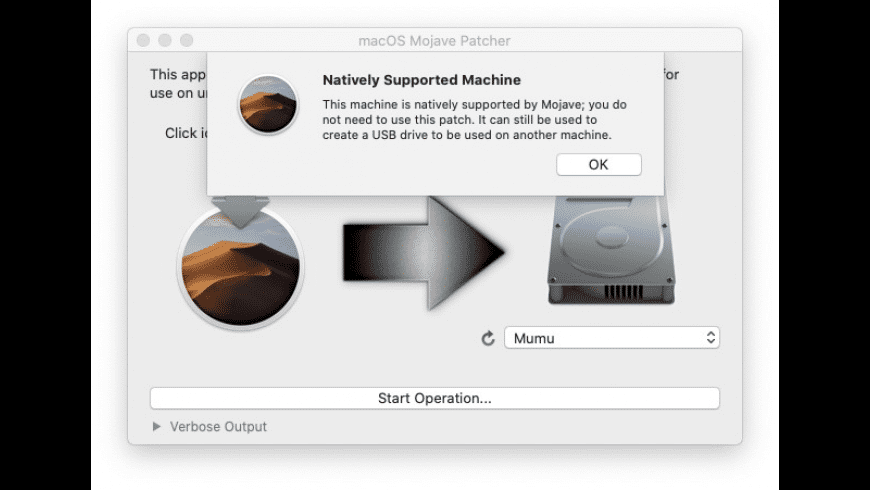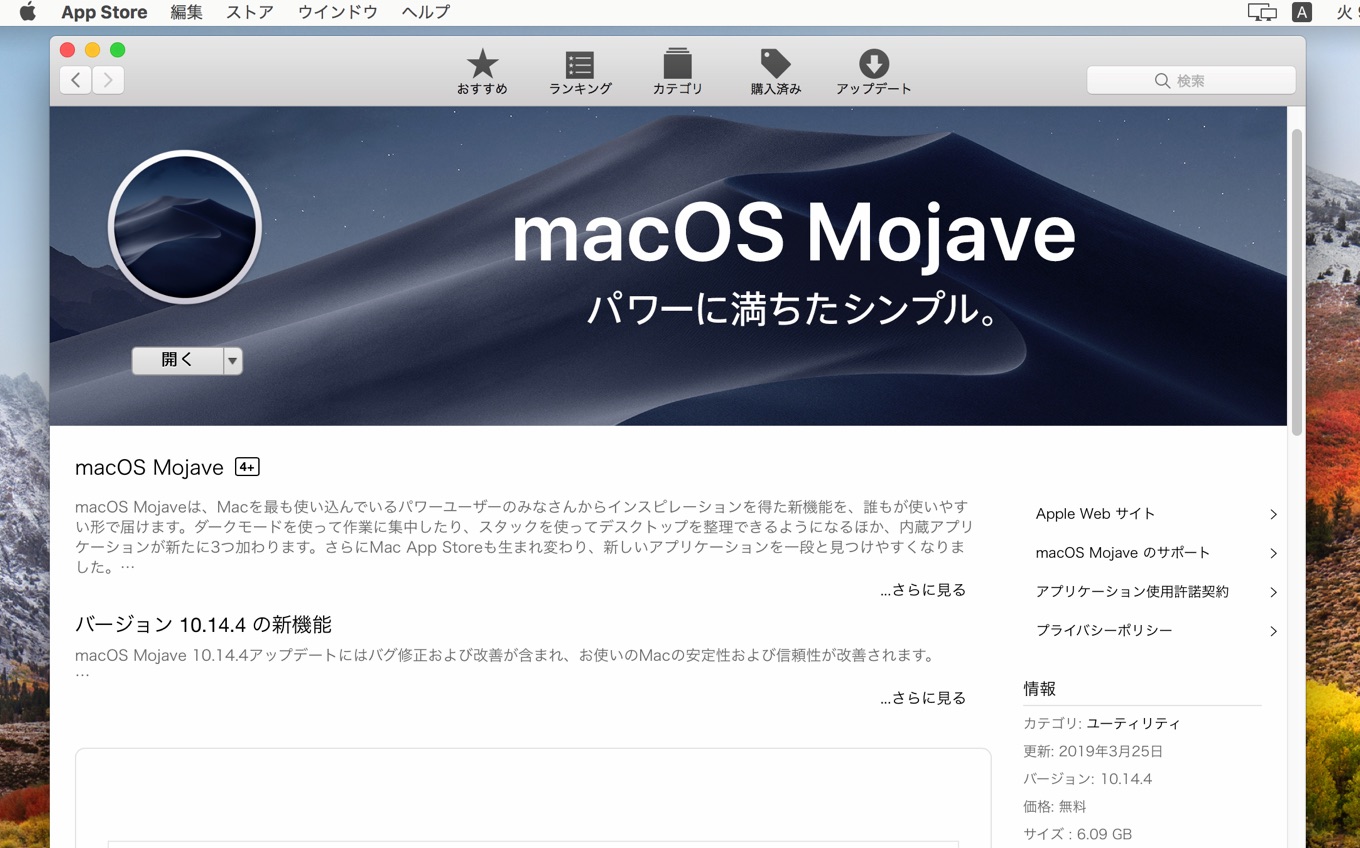Macos Mojave Patcher
Description:

Apple has finally released macOS 10.14, named Mojave after one of California's three deserts. If your organisation is itching to upgrade Mojave update to multiple Mac devices, the Upload Patch feature lets you perform the deployment efficiently.
System Requirements
You can upgrade your Mac operating system to Mojave 10.14, only if the following system requirements are met:
MacOS Mojave Patcher is an application that lets you run macOS 10.14 on unsupported hardware. It is developed by developer Dosdude who also developed similar patches for Sierra and High Sierra firmware. It automatically downloads the latest Public Beta version from Apple’s servers and creates a bootable image out of it. MacOS Patcher is a command line tool for running macOS Sierra, macOS High Sierra, macOS Mojave, and macOS Catalina on unsupported Macs Catalina Unus It's integrated into macOS Patcher so you if you have a Mac supported by it, you can create your patched installer using Catalina Unus, and then add macOS Patcher's patches to it by selecting the. The last macOS release for the Mac Pro 5,1 is Mojave 10.14.6. So you can install any of the Polaris and Vega graphics cards in a 5,1 listed before macOS 10.15 provided all other requirements such as size and power needs are met. There is a detailed section towards the end of this first post about power requirements for Vega graphics cards. MacOS Catalina Patcher lets you install macOS Catalina on Mac computers that are no longer officially supported. It can help you create a bootable USB drive that can be used to install macOS Catalina on Mac computers older than mid 2012.
- Computer should be running on Mac 10.8 or later versions.
- A minimum of 18.5 GB free space is required on the hard disk.
- A minimum of 2 GB RAM memory is required.
- Mac Pro (mid 2010 and mid 2012 models) must first be updated to macOS High Sierra 10.13.6 before updating to macOS Mojave.
- You can refer this link for more details : MacOS 10.14 Mojave System Requirements.
Steps:
- Open App Store in one of the managed Mac devices.
- Click on the macOS Mojave icon and choose to download.
- Find the installation file 'Install macOS Mojave' in Applications folder by navigating to the file path /Applications/
- Compress the installation file using the following command
'tar -zcvf installMojave.tar.gz Install macOS Mojave.app/'
Note: The User should not execute the above command in some other directory. Go to the Applications folder(as mentioned in the file path) and execute that exact command in that folder to compress the installation file.
In order to deploy the macOS Mojave patch to Mac devices missing the latest version, it is required to upload the installation file to our patch store using the following steps:
(Note: This option is only available for the build 10.0.282 and above).
Macos Mojave Download
- Navigate to Patches > Downloaded patches > upload patches.
- Here you will find a list of patches that have to be downloaded manually. Apply the filter 'Missing patches in the network' and find the 'Upgrade to macOS Mojave' option under 'Patch Description'.
- Select Upload option.
- Navigate to the location of the downloaded patch file in and upload it.
- Now, the patch will be successfully uploaded to the patch store, and will be available for deployment.
Using our Install Patch configuration, you can deploy the Mojave update to all the Mac devices in your network.

Today I will tell you how to install macOS Mojave or other fresh macOS on an unsupported Mac using the Mojave Patcher Tool. This utility is available for free. You can see more information and patcher updates here on a dosdude site.
Attention! Do not forget! You carry out all actions with the computer and the program at your own peril and risk! No one is responsible for damage to your computer or loss of data except you! If you have crooked hands, do not grab it!

Read more: How to Install Boot Camp and Install Windows 10 on Mac?
Devices Supported
Early-2008 or newer Mac Pro, iMac, or MacBook Pro:
- MacPro3,1
- MacPro 4.1
- iMac8.1
- iMac9.1
- iMac10, x
- iMac11, x (systems with AMD Radeon HD 5xxx and 6xxx series GPUs will be almost unusable when running Mojave. More details are located in the Known Issues section below.)
- iMac12, x (systems with AMD Radeon HD 5xxx and 6xxx series GPUs will be almost unusable when running Mojave. More details are located in the Known Issues section below.)
- MacBookPro 4.1
- MacBookPro5, x
- MacBookPro6, x
- MacBookPro 7.1
- MacBookPro8, x
Late-2008 or newer MacBook Air or Aluminum Unibody MacBook:
- MacBookAir2.1
- MacBookAir3, x
- MacBookAir4, x
- MacBook 5.1
Early-2009 or newer Mac Mini or white MacBook:
- Macmini 3.1
- Macmini 4.1
- Macmini5, x
- MacBook 5.2
- MacBook 6.1
- MacBook 7.1
Early-2008 or newer Xserve:
- Xserve2.1
- Xserve3.1
Devices that ARE NOT Supported
2006-2007 Mac Pros, iMacs, MacBook Pros, and Mac Minis:

- MacPro1,1
- MacPro2,1
- iMac4.1
- iMac5, x
- iMac 6.1
- iMac7.1
- MacBookPro1,1
- MacBookPro2, x
- MacBookPro3.1
- Macmini1,1
- Macmini 2.1
- The 2007 iMac 7.1 is compatible if the CPU is upgraded to a Penryn-based Core 2 Duo, such as a T9300
2006-2008 MacBooks:
Macos Mojave Patcher Tool For Unsupported Macs

- MacBook1.1
- MacBook 2.1
- MacBook 3.1
- MacBook 4.1
- 2008 MacBook Air (MacBookAir 1.1)
What Do you Need?
A copy of the macOS Mojave Installer App. This can be obtained from the Mac App Store using a machine that supports Mojave, or by using the built-in downloading feature of the tool. In the Menu Bar, simply select “Tools -> Download macOS Mojave …“
Read more: How to Resize Partition on a Mac?
Macos Mojave Patcher Tool
How to Install macOS Mojave with Mojave Patcher Tool?
- Insert a suitable USB flash drive, open Disk Utility and format it in OS X Extended(journal);
- Open “macOS Mojave Patcher” and specify the path to your macOS Mojave installer;
- Select your flash drive in the list of devices and click “Start”;
- After the operation is complete, restart your Mac with the Option (Alt) button pressed, select your USB flash drive in the boot menu;
- Install macOS on the selected drive partition;
- When the installation process is complete, reboot the device by selecting the installer disk to boot. After that, open the macOS Post Install application;
- In the application window, select your Mac model. You will be offered the best patches based on the selected model. You can also mark other patches as desired;
- Select the partition on which macOS Mojave was installed, and click Patch. When the process is complete, click “Reboot”;
- Rebuilding the cache before rebooting the system may take some time! Note: If for some reason the system does not work correctly after rebooting, restart your Mac with the Option (Alt) button pressed, select the installer disk in the boot menu, then run the Post Install patch again and select the “Force Cache Rebuild” option. Then reboot the device;
- When the Mac reboots, it will launch a fully working version of macOS Mojave.
Macos Mojave Supported Macs
Conclusion
Macos Mojave Patcher For Unsupported Macs
When you install the system using the macOS Post Install tool, a program called Patch Updater (Applications/Utilities folder) will appear on your Mac. This app will inform you about patch updates available for your device and offer to install them.